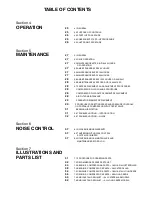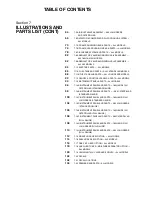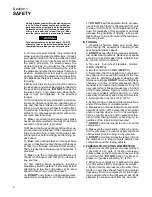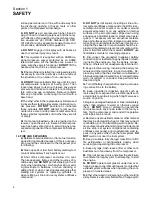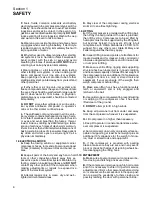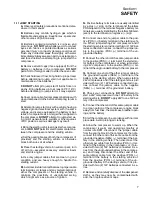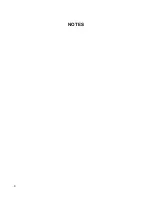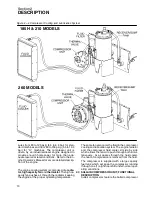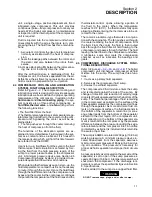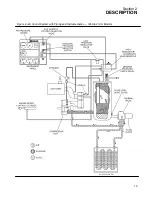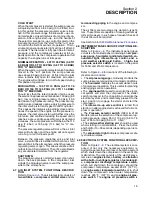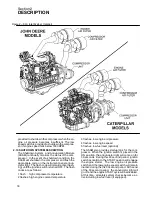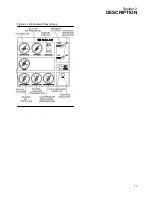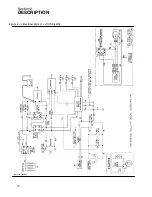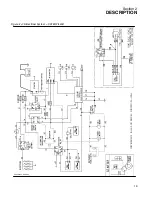
Section 1
SAFETY
5
ders, or maintain or troubleshoot these systems
only in well---ventilated areas away from heat, open
flame or sparks.
DO NOT
install, store or otherwise
expose ether cylinders to temperatures above
160
_
F (71
_
C). Remove ether cylinder from the
compressor when operating in ambient tempera-
tures above 60
_
F (16
_
C).
P. DO NOT
attempt to use ether as a starting aid in
gasoline engines or diesel engines with glow plugs
as serious personnel injury or property damage
may result.
Q. DO NOT
spray ether into compressor air filter or
into an air filter that serves both the engine and the
compressor as serious damage to the compressor
or personal injury may result.
R.
Antifreeze compound used in air line anti---icer
systems contains methanol which is flammable.
Use systems and refill with compound only in well---
ventilated areas away from heat, open flames or
sparks.
DO NOT
expose any part of these systems
or the antifreeze compound to temperatures above
150
_
F (66
_
C). Vapors from the antifreeze com-
pound are heavier than air.
DO NOT
store com-
pound or discharge treated air in confined or un-
ventilated areas.
DO NOT
store containers or anti-
freeze compound in direct sunlight.
S.
Store flammable fluids and materials away from
your work area. Know where fire extinguishers are
and how to use them, and for what type of fire they
are intended. Check readiness of fire suppression
systems and detectors if so equipped.
1.5 MOVING PARTS
A.
Keep hands, arms and other parts of the body
and also clothing away from belts, pulleys and
other moving parts.
B. DO NOT
attempt to operate the compressor
with the fan or other guards removed.
C.
Wear snug---fitting clothing and confine long hair
when working around this compressor, especially
when exposed to hot or moving parts inside the en-
closure.
D.
Keep access doors closed except when making
repairs or adjustments, performing service or when
starting or stopping the compressor.
E.
Make sure all personnel are out of and clear of
the compressor prior to attempting to start or oper-
ate it.
F.
Shut off engine before adding fuel, fluid, coolant
lubricants, air line antifreeze compound or battery
electrolyte, or before replacing ether starting aid
cylinders.
G.
Disconnect the grounded negative battery con-
nection to prevent accidental engine operation
prior to attempting repairs or adjustments. Tag the
battery connection so others will not unexpectedly
reconnect it.
H.
When adjusting the controls, it may require op-
eration of the equipment during adjustment.
DO
NOT
come in contact with any moving parts while
adjusting the control regulator and setting the en-
gine RPM. Make all other adjustments with the en-
gine shut off. When necessary, make adjustment,
other than setting control regulator and engine
RPM, with the engine shut off. If necessary, start the
engine and check adjustment. If adjustment is in-
correct, shut engine off, readjust, then restart the
engine to recheck adjustment.
I.
Keep hands, feet, floors, controls and walking
surfaces clean and free of fluid, water, antifreeze or
other liquids to minimize possibility of slips and
falls.
1.6 HOT SURFACES, SHARP EDGES AND SHARP
CORNERS
A.
Avoid bodily contact with hot fluid, hot coolant,
hot surfaces and sharp edges and corners.
B.
Keep all parts of the body away from all points of
air discharge and away from hot exhaust gases.
C.
Wear personal protective equipment including
gloves and head covering when working in, on or
around the compressor.
D.
Keep a first aid kit handy. Seek medical assis-
tance promptly in case of injury.
DO NOT
ignore
small cuts and burns as they may lead to infection.
1.7 TOXIC AND IRRITATING SUBSTANCES
A. DO NOT
use air from this compressor for respi-
ration (breathing) except in full compliance with
OSHA Standards 29 CFR 1920 and any other Fed-
eral, State or Local codes or regulations.
DANGER
!
Death or serious injury may occur from inhaling
compressed air without using proper safety
equipment. See OSHA standards, and/or any
Federal, State or Local codes or regulations on
safety equipment.
B. DO NOT
use air line anti---icer systems in air
lines supplying respirators or other breathing air
utilization equipment and
DO NOT
discharge air
from these systems into unventilated or other con-
fined areas.
C.
Operate the compressor only in open or well---
ventilated areas.
D.
If the compressor is operated indoors, dis-
charge engine exhaust fumes outdoors.
E.
Locate the compressor so that exhaust fumes
are not apt to be carried towards personnel, air in-
takes servicing personnel areas or towards the air
intake of any portable or stationary compressor.
Summary of Contents for 185H
Page 6: ......
Page 14: ...8 NOTES...
Page 20: ...Section 2 DESCRIPTION 14 Figure 2 4B Control System with Piping and Instrumentation 260 Models...
Page 23: ...Section 2 DESCRIPTION 17 Figure 2 6 Instrument Panel Group...
Page 24: ...Section 2 DESCRIPTION 18 Figure 2 7 Electrical System JOHN DEERE 02250144 446R05...
Page 25: ...Section 2 DESCRIPTION 19 Figure 2 7A Electrical System CATERPILLAR P02250144 395R04...
Page 26: ...20 NOTES...
Page 30: ...24 NOTES...
Page 36: ...Section 5 MAINTENANCE 30 Figure 5 4 Control System Adjustment 185H 210 MODELS 260 MODELS...
Page 42: ...36 NOTES...
Page 49: ...Section 7 ILLUSTRATIONS AND PARTS LIST 43 NOTES...
Page 90: ...Section 7 ILLUSTRATIONS AND PARTS LIST 84 7 10 ELECTRICAL PARTS ALL MODELS 02250148 897R00...
Page 128: ...Section 7 ILLUSTRATIONS AND PARTS LIST 122 7 20 DECALS...
Page 130: ...Section 7 ILLUSTRATIONS AND PARTS LIST 124 7 20 DECALS...
Page 132: ...Section 7 ILLUSTRATIONS AND PARTS LIST 126 7 20 DECALS...
Page 134: ...Section 7 ILLUSTRATIONS AND PARTS LIST 128 7 20 DECALS...
Page 136: ...Section 7 ILLUSTRATIONS AND PARTS LIST 130 7 20 DECALS...
Page 138: ...Section 7 ILLUSTRATIONS AND PARTS LIST 132 7 21 DECAL LOCATIONS 02250149 633R01...
Page 142: ......
Page 143: ......




